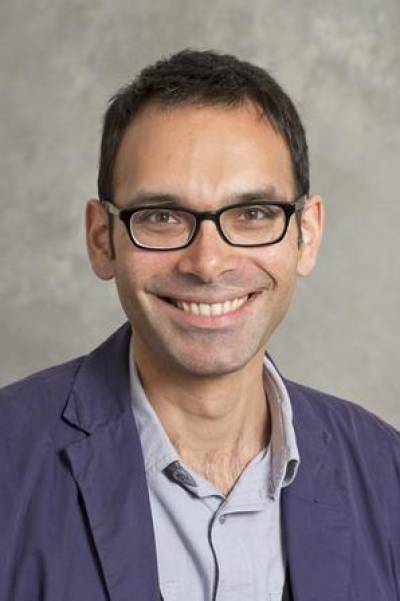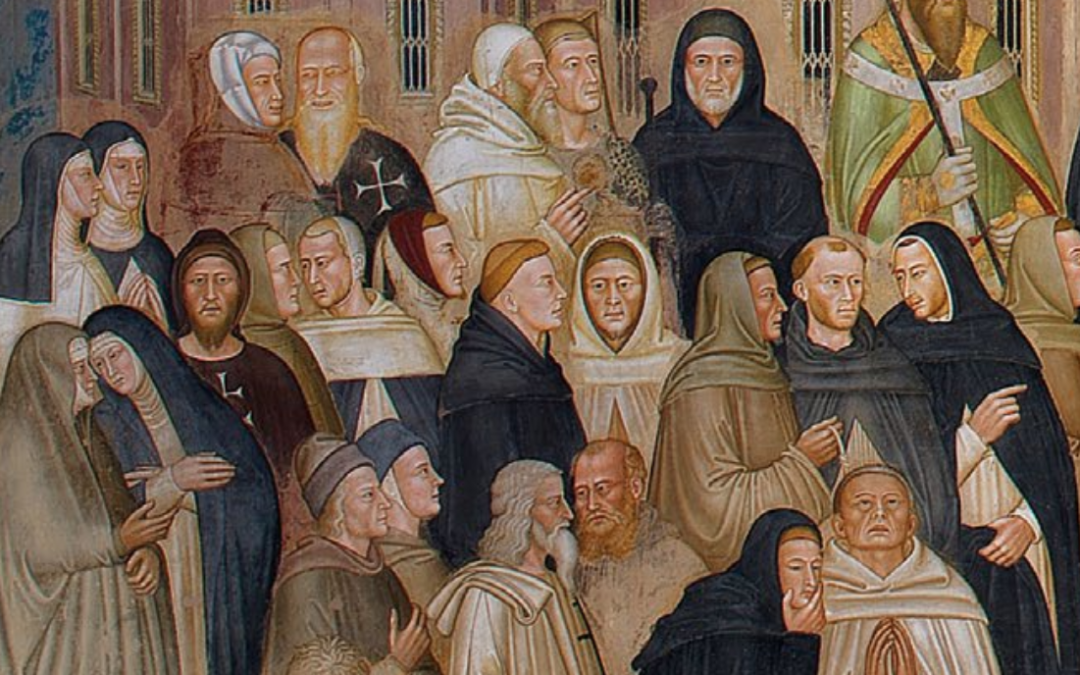By John Sabapathy
In July 2020, University of London press published Individuals and Institutions in Medieval Scholasticism, the latest title in New Historical Perspectives, an Open Access series for early career historians from the IHR and the Royal Historical Society.
In this post, editor John Sabapathy introduces the volume, considers the value of collaborative working with ECR researchers, and the resonance of scholasticism in current debates over humanities research.
Historians like dealing with individuals. Their enthusiasm about institutions has been less apparent over recent decades. In part this is due to an understandable reaction against institutions’ longstanding dominance of historical curricula, often in the classic forms of parliaments, political parties, governmental apparatuses ‘the Church’ and the like. If institutions could never entirely go away though, they have certainly become a less modish topic for historical analysis. ‘Institutional’ risks becoming one of the more boring essential adjectives in the historian’s lexicon. Yet, given their centrality to all human activity, past or present, any society which starts to find institutions uninteresting is in deep trouble. Our new edited collection, Individuals and Institutions in Medieval Scholasticism—just published in the Royal Historical Society’s New Historical Perspectives series, by the Institute of Historical Research and the University of London Press—arose from an observation that there was important work to be done on this inside the historiography of one the Middle Ages’s totemic products: scholasticism.

Scholasticism was a strange cumulative lump of authoritative texts, pedagogical forms, interpretative devices, analytical styles, organizational structures, and Christian ideological armature. It was extraordinarily long-lived (say the twelfth to the seventeenth century), extraordinarily widely dispersed across Europe, and extraordinarily powerful. Many of its techniques persist today and still shape aspects of university life, itself of course a medieval invention. Its experts were called upon to judge various causes célèbres, from the destruction of the Templars to whether popes held heretical views. ‘Scholasticism’ then was in no way confined to universities, but rather spilled out to inform and shape many other public debates and problems.
So scholasticism was explosive at points, perhaps an unexpected claim for an ensemble intended to determine painstakingly the truth about the world. Then again, perhaps it is entirely predictable that such a venture would generate much heat and light for its contemporaries. The history of scholastic individuals and institutions has been generally treated either as a simple intellectual genealogy of schools and doctrines, or a constitutional history of particular organizational forms. Individualization has often been seen as a matter of dissent and heterodoxy in relation to orthodox teachings or ideas (dissenters, such as Peter Abelard, generally being more ‘individual’ than ‘orthodox’ thinkers). ‘Institutionalization’ itself has tended historiographically to comprise successive exercises in the promulgation of organizational statutes, risking static and sterile histories.
Neither individuals, their institutions, nor scholasticism have been especially well-served by such approaches. Yet scholasticism is interesting precisely because it so obviously combines the ‘turboprof’ individualism of an Abelard, with a spread of institutional practices (the lecture, the commentary, the gloss, curricula etc.) and a pick and mix of organizational forms (faculties, colleges, ethnic ‘nations’). Individuals and institutions interpenetrate to the greatest degree. The field is, indeed, a good case study for those interested more widely in such interactions.

However, historians have, as I say, less often foregrounded the ways that the different layers co-determined one another or how they interacted and conflicted in different contexts. That is what our new collection does. An interesting example, examined in our introduction, is the great R. W. Southern (1912-2001), a former president of the Royal Historical Society. Southern worked on both individuals (St Anselm), intellectual practices (his opus magnum on Scholastic Humanism and the Unification of Europe) and ‘harder’ organizational aspects of medieval thought, but often in distinct registers.
In our introduction Antonia Fitzpatrick and I use cases such as Southern’s to open out different approaches that medieval historians have taken to both individuals and ‘individualism’, as well as a range of techniques useful for analysing institutions (from Alasdair MacIntyre’s traditions to Mary Douglas’s thought styles to Niklas Luhmann’s systems thinking). Both the introduction and the volume as a whole deliberately bring together work from different European historiographical traditions—a point nicely analysed in David d’Avray’s afterword. A deal of this is not readily accessible in English and another aim is to provide students with a stocktaking as well as a clear sense of some important recent approaches to these topics. Individuals and Institutions also quite deliberately brings together a range of senior and more junior voices—that the New Historical Perspectives series itself is designed to welcome early career researchers is entirely fitting.
We hope an edited volume like this can counterpoint such contrasting perspectives in a way that the synthetic vision of a monograph could not. In the volume Gert Melville and Sylvain Piron’s chapters exemplify this nicely. Melville is interested in how the charisma of the organic intellectual founding new religious groups becomes formally institutionalized, informed by scholastic modes. Piron’s analysis of the Franciscans by contrast shows how the charismatic Peter John Olivi used his scholastic arsenal to interrogate the institutional form of his own organization, the Franciscans.
Each contributor takes very different approaches to charisma, rules, institutions, and individuals: the ensemble chorus in an edited volume can be a wonderful thing. Edited volumes have a vital place in the scholarly ecosystem but many British-based academic presses seem increasingly wary of them, in contrast to the increasingly ubiquitous ‘handbook’.
Handbooks can be as stimulating as edited volumes can be disappointing, but it is hard not to conclude that publishers’ commercial imperatives are driving the uncritical growth of one alongside the decline of the other. In that respect we are very proud to be the first edited volume in the NHP series. That it is available open access should only make its contents all the more accessible to readers.

If this is a book of intellectual history we hope it is not only for Intellectual Historians. Given scholasticism’s generally negative popular profile (theological, narrow, technical, rigid, dull) we understandably wanted this collection to exemplify something different. So the volume includes analysis of history’s development as a discipline (Matthew Kempshall on Nicholas Trevet), scholastic poetry’s role in creating the cult of Mary and Joseph (Isabel Iribarren on Jean Gerson’s Josephina), pastoral care and pratical ethics writ large (Emily Corran, John Sabapathy, and Cornelia Linde’s articles), as well as legal practice as it develops (Peter Biller on inquisition) and is disputed (Linde on confession). There is of course theology and metaphysics too: Antonia Fitzpatrick on Franciscan and Dominican disagreements about the metaphysics of body and soul and John Marenbon on Pietro Pomponazzi’s careful arguments about how one may and may not argue for the soul’s immortality. We aimed to structure the book around the core issues above as they fall out of the introduction’s discussion. The first half therefore discusses the relationship between individuals and intellectual traditions, incorporating both the construction and criticism of those traditions.
Here Blaise Dufal kicks things off very nicely by showing how intellectuals used the Church Fathers (Jerome, Augustine, Ambrose, Gregory the Great) to create a genealogy for themselves which could be both corporate and individualistic. The book’s second half focuses more on the back and forth between individuals and their institutions whether that is in terms of organizations (religious orders, the construction of inquisition) or social practices reliant on scholastic thought (confession, casuistry, ethics, pastoral care, doctrine).
Taken as a whole the volume aims to show scholasticism’s longevity, starting with the reception of Blaise Dufal’s church fathers from the twelfth century and ending with Marenbon’s Pomponazzi in the early sixteenth century. In that respect Individuals and Institutions is in line not only with Jacques Le Goff’s older argument about a very long Middle Ages but also with much more recent work, such as Robert Pasnau’s, showing how scholastic metaphysical traditions extend deep into the seventeenth century.

***
The Middle Ages was a period when learning and education were extremely creative, extremely exclusive, and extremely ideologically driven. Institutions of higher learning and their members were closely aligned to ecclesiastical and secular powers. Individualism could be orthodox or unorthodox. Dissent could be dangerous. At points, corporate university bodies could indeed articulate themselves with some autonomy towards the powers that be. British universities are now seemingly embarking on another era of deep institutional reform centred on contentious arguments about the hierarchy of disciplines, the purpose of education, its costs and accessibility and driven by central government. Dealing with Brexit would have been upheaval enough. Just before the government’s ‘direction of travel’ was made clear this summer the British Academy outlined terms for articulating the value of the arts, social and historical sciences as ‘SHAPE’ in counterpoint to STEM subjects. The next endgame remains to be played.
Plainly the medieval configuration of academic disciplines and pedagogical purposes was very distinct from today’s, but the issues of instrumentality, control, and autonomy are interestingly recurrent. Understanding how educational institutions, their individual members and their wider societies have interacted to shape one another, for better or worse, remains a topic of enduring resonance.

John Sabapathy is Associate Professor of Medieval History at University College London (@jwwsabapathy).
He is the co-editor with Antonia Fitzpatrick of Individuals and Institutions in Medieval Scholasticism, published on 30 July by the IHR and University of London Press.

Individuals and Institutions in Medieval Scholasticism is available as a free Open Access pdf and also to purchase in hardback (£40) and paperback (£25) print. A 30% discount is available via the code WISDOM30 redeemable either from the University of London Press site or our North American distributor, University of Chicago Press.

New Historical Perspectives is a book series for early career scholars within the UK and the Republic of Ireland. Commissioning and editing is undertaken by the Royal Historical Society, and the series is published under the imprint of the Institute of Historical Research by the University of London Press.
The series is supported by the Economic History Society and the Past and Present Society. All NHP titles are published as free Open Access, and in hard and paperback print, with book processing charges covered by the participating institutions. Proposals from early career historians for monographs and edited collections are welcome.

